 Bob Chenoweth - Arts & Crafts Coffee table - “Fine Woodworking”
intermediate level plan (Taunton Product #011219) by Kevin Rodel,
Pownal, Maine. Fumed white oak and satin polyurethane finish with
beveled through tenons, grid work stretcher, half lap joints and
breadboard ends with ebony inserts.
Bob Chenoweth - Arts & Crafts Coffee table - “Fine Woodworking”
intermediate level plan (Taunton Product #011219) by Kevin Rodel,
Pownal, Maine. Fumed white oak and satin polyurethane finish with
beveled through tenons, grid work stretcher, half lap joints and
breadboard ends with ebony inserts.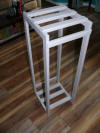 Gary
Rowen - I crafted another blanket rack for the daughter of friends of
ours but redesigned it so that all the slats could be cut from one 1x6x8
except for the CNC engraved name plate. It was stained then
finished with
brushed on lacquer.
Gary
Rowen - I crafted another blanket rack for the daughter of friends of
ours but redesigned it so that all the slats could be cut from one 1x6x8
except for the CNC engraved name plate. It was stained then
finished with
brushed on lacquer.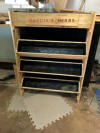
Tim
Shaunty - This is a patio vertical herb garden I made for a friend. It
is made from cedar fence pickets and is painted with FlexSeal to stop
leaks. Of course, after stopping the leaks, I drilled holes to allow
for drainage. It has L brackets to attach to their fence so wind
shouldn't be a problem.
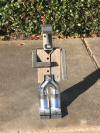
Bob
Wink - Another Wink production-”Muffler Man” made from wood and tailpipe
extensions
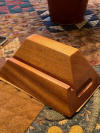
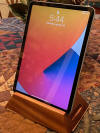
Jack
Bailie - My wife requested a stand to hold her new iPad. This is what I
came up with after four prototypes. We finally settled on 25 degree
angles. It is a little difficult to pick up, so I made grooves in the
ends to make it easier. It is made from some left over mahogany and
finished with General Finishes Arm-R-Seal. Now she wants one made from
Oak!


Sonny
Lawson - Made a couple of chairs for my nephew as a wedding present from
some pictures and measurements of a mid-century original. Used
templates with a router table to dimension the shaped parts.
Chairs were finished with an aniline dye and Arm R Seal. Cushions
were purchased online. Never realized chairs had so many angles!
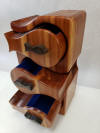
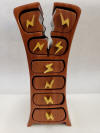
Norm
Nichols - I gave my scroll saw a few days off and turned on the band
saw. Both boxes are aromatic cedar with 5-6 coats of lacquer. Drawers
are lined with navy blue Flockit. Back to the scroll saw.
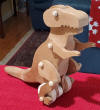
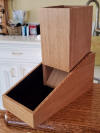
Tom
Paulley -
Item
#1 Dice Tower made from rift-sawn white oak, finished with Watco Danish
Oil Natural, and flocked with black velvet. Plans from Marc
Sagnuolo.

Rick
Spacek - This is a Space Force plaque I cut.
The letters are raised. The inner and outer rings are raised.
There is black velour paper in center and the center emblem, Roman
numbers, are raised.
Painted with acrylic paints



Andy
Tofuri/Dave VanDewerker - Dave VanDewerker and I have spent some time
trying to come up with some new toys as requested by some of the
organizations. The pattern matching toy showed up in a random search
for wood toys. Dave made a template on his scroll saw for Andy to
router the slot. Andy built the frames. The plate and bottom are 1/4"
Winkwood1 pre-treated drawer bottoms that Bob brought to the
January tool/wood swap. The round puzzle pieces are 1" wheels with the
flat side out. The pattern cards were created in Excel, printed on card
stock, and cut (which was the most time consuming part of the project).
So far we have 16 completed. Andy has the template and plans for anyone
interested in building some of these.
The Animal Puzzle was cut
by Dave on the scroll saw. Andy built the box. All of the wood is from
our favorite moulding mill's scraps with the exception of the Winkwood1
box bottom. Puzzle parts are unfinished poplar, the frames are soft
maple or alder.
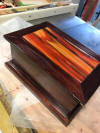
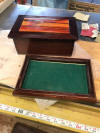
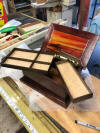
Keith
Van Tassel - Three views of a jewelry box I made for my brand new
daughter-in-law for Christmas. The box is made from
repurposed mahogany from my neighbor's old bedstead that he was going to
just throw in the trash. The lid features what I believe is called
flame wood. The small trays that fit inside the box are made from curly
maple and walnut. The box also features a hidden compartment in
the base. I got the idea for the hidden compartment from an
old Wood magazine project.




Dave
VanDewerker – Some random turnings that I made over the weekend, still
learning. A Pecan bowl, Hackberry plate (was a bowl), two Alder lidded
boxes, a goblet and lidded box made from glued up scraps.
Also was making a platter that turned into a frisbee and a lidded
box that turned into a tube.
Chris
Farquhar -
This
is a cell phone holder I made so my wife could have her phone set up
next to the computer while she works from home. Very handy when she
needs to have a "Facetime" during working hours; it's all adjustable. I
got the idea from seeing a picture on Pinterest. I do not know the type
of wood; just some scraps I had in the shop. The finish is Danish Oil
then a paste wax.


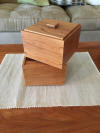
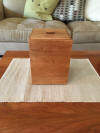
Mike
Hardy - Cherry and Pecan Stacking Box. Total 6"x6"x8", finished with
shellac on the inside and Liberon on the lids and the outside. I did
have to fill some cracks in the lower lid with epoxy.
Lon
Kelley - This bowl is made from poplar and padauk. The method was to cut
the bowl in half and put in the angled stripe. (What you cut a perfectly
good bowl in half?) Finished with poly and wax.
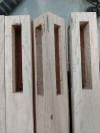
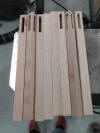



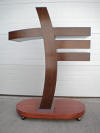
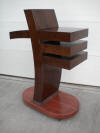
![]()
![]() David
Janowitz - This is a church lectern in the shape of their logo.
Just under 5’ tall, 40" wide, and 18" deep. My biggest challenge
was figuring out construction so that it could be assembled and very
sturdy. People will certainly lean heavily on the top shelf, so
the top and bottom panels go right through the vertical, as do the lower
shelves. A maple internal framework supports 3/4" Walnut veneer
plywood, with the curved panels being 3 layers of 1/4" ply, glued
together, and the front and back surfaces double thick. (Only the
outside is walnut, to save cost.) The rear of the shelves are open
for storage, not visible to the audience. The base is 3" thick
solid Water Oak, and has a 6"x18" mortise accommodating the vertical
cross, which is lag-screwed into place. Given the curves, all the
parts attach at different crazy angles, including the 71 degree base
mortise. They wanted the cross stained dark, and I believe it was
Denis' suggestion to use a gel stain on the oak base, which worked
nicely. I had to pre-finish everything with stain and water borne
urethane before assembly given the tight spaces, and top, side, and
bottom surfaces. It took longer than it should have, but I learned
new skills on this, and had to dust off my high school geometry for the
angles.
David
Janowitz - This is a church lectern in the shape of their logo.
Just under 5’ tall, 40" wide, and 18" deep. My biggest challenge
was figuring out construction so that it could be assembled and very
sturdy. People will certainly lean heavily on the top shelf, so
the top and bottom panels go right through the vertical, as do the lower
shelves. A maple internal framework supports 3/4" Walnut veneer
plywood, with the curved panels being 3 layers of 1/4" ply, glued
together, and the front and back surfaces double thick. (Only the
outside is walnut, to save cost.) The rear of the shelves are open
for storage, not visible to the audience. The base is 3" thick
solid Water Oak, and has a 6"x18" mortise accommodating the vertical
cross, which is lag-screwed into place. Given the curves, all the
parts attach at different crazy angles, including the 71 degree base
mortise. They wanted the cross stained dark, and I believe it was
Denis' suggestion to use a gel stain on the oak base, which worked
nicely. I had to pre-finish everything with stain and water borne
urethane before assembly given the tight spaces, and top, side, and
bottom surfaces. It took longer than it should have, but I learned
new skills on this, and had to dust off my high school geometry for the
angles.
I answered that request to build a wooden practice polo horse, and made this. It is all white oak, except the legs, which are just pressure treated wood. No joinery, just lots of countersunk exterior screws, and a few galvanized bolts. I treated it with Olympic Maximum Clear Waterproofing Sealant, top rated by Consumer Reports, and rated for 3 years on decks, and 4 on fencing. (Why it is called Clear is beyond me, as it is quite orange.) All the edges are 1/4" roundover, the head I cut out on a band saw, and that piece passes through the front and attaches in the center piece.